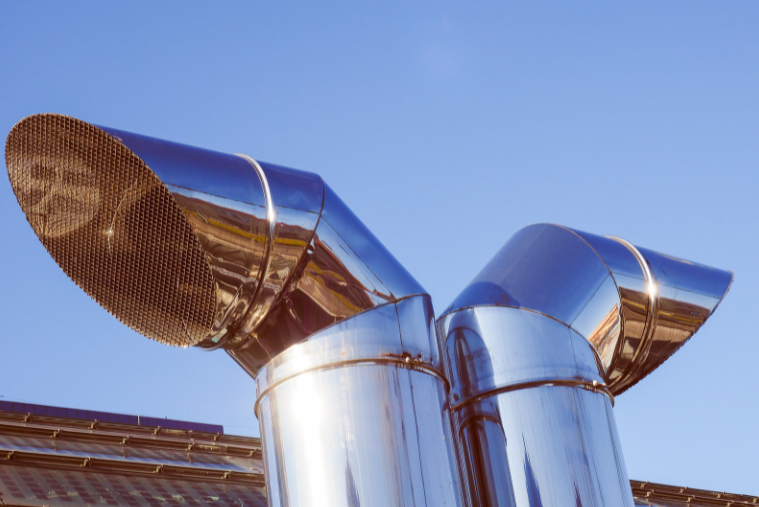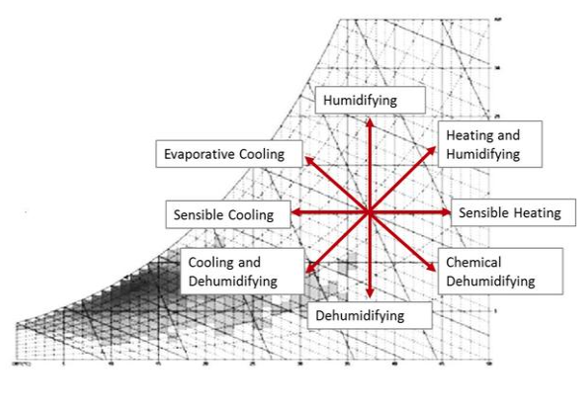Psychrometrics – The Essence of HVAC

Psychrometrics is the study of the thermodynamic properties of air-vapor mixtures, typically focusing on the interrelation among temperature, partial pressures, and enthalpy. A psychrometric chart presents the physical and thermal properties of moist air in a graphical form.
 The properties of air on the chart include dry-bulb temperature, wet-bulb temperature, dewpoint temperature, enthalpy (BTUs per lb. of air), humidity ratio (grains of moisture per lb. of dry air), relative humidity (percent), and specific volume (cubic feet per lb. of dry air).
The properties of air on the chart include dry-bulb temperature, wet-bulb temperature, dewpoint temperature, enthalpy (BTUs per lb. of air), humidity ratio (grains of moisture per lb. of dry air), relative humidity (percent), and specific volume (cubic feet per lb. of dry air).
So why the essence of HVAC? ASHRAE defines a comfort quadrangle which varies from 68-74 F (winter), 72-80 F (summer), and 30-60% relative humidity. The indoor design points (winter and summer) will typically fall within this range. There are exceptions, but most HVAC designs are based on human comfort. One exception could be an industrial process that requires space conditions outside the quadrangle for successful material processing. Properly designing our systems to maintain space conditions will ultimately determine the success of our efforts.
Within a thermal zone (area within a building where we are controlling the temperature and humidity) there are several factors that cause the temperature and humidity to fluctuate. Those factors would include people at work (heat and moisture), lighting, heat-producing equipment, heat transfer (in or out of the building) through walls, glass, roofs, or doors, infiltration (leaking of outside air into the building), and moisture sources within the space. All these sources combined determine the sensible (dry heat) and latent (moisture) loads within the zone. Through a series of calculations, we will determine the airflow (cfm) and temperature of air (dry bulb and wet bulb) we need to deliver to the zone to maintain setpoints.
We normally introduce outdoor air at the air handling unit serving the zone and blend it with return air from the zone. Outdoor air is utilized primarily to pressurize the zone (reduce or eliminate infiltration) and provide better indoor air quality by diluting contaminants in the zone. The blending of the outdoor air and return air give us a mixed air temperature. The mixed air is the entering temperature to the cooling or heating coil, and the leaving air temperature is controlled to condition the zone to its setpoint. We determine the energy required by comparing the enthalpy of the entering and leaving conditions of the air through the coil(s) along with the airflow (cfm). The mixed air conditions are constantly changing throughout the day and year and offer the biggest challenge to keeping the zones regulated.
Psychrometrics and the psychrometric chart provide the tools necessary to begin the design of our air conditioning systems. They provide the necessary properties of air at various stages in the system and give us a visual representation (psychrometric chart) of the condition of the air at those various stages.
Look for a future blog on what impact energy recovery can have on the psychrometrics of our HVAC systems.
// about the author
 Mike Crowder, P.E.
Mike Crowder, P.E.
Mike graduated from Mississippi State Universityin1977with a B.S. in Mechanical Engineering. He joined Hoffman & Hoffman in January 2003 as a sales engineer where he has worked with engineers, contractors, and end-users. Mike became a LEED Accredited Professional in 2009. He was promoted to branch manager of the Chattanooga, TN office in September 2009 and now serves as our Sales Manager in Columbia, SC. Throughout his professional career, Mike has been involved with ASHRAE serving as President of the South Carolina Chapter in 1984-85 and receiving the Regional Award of Merit in 2000. Mike and his wife, Julie have four children and five grandchildren.












